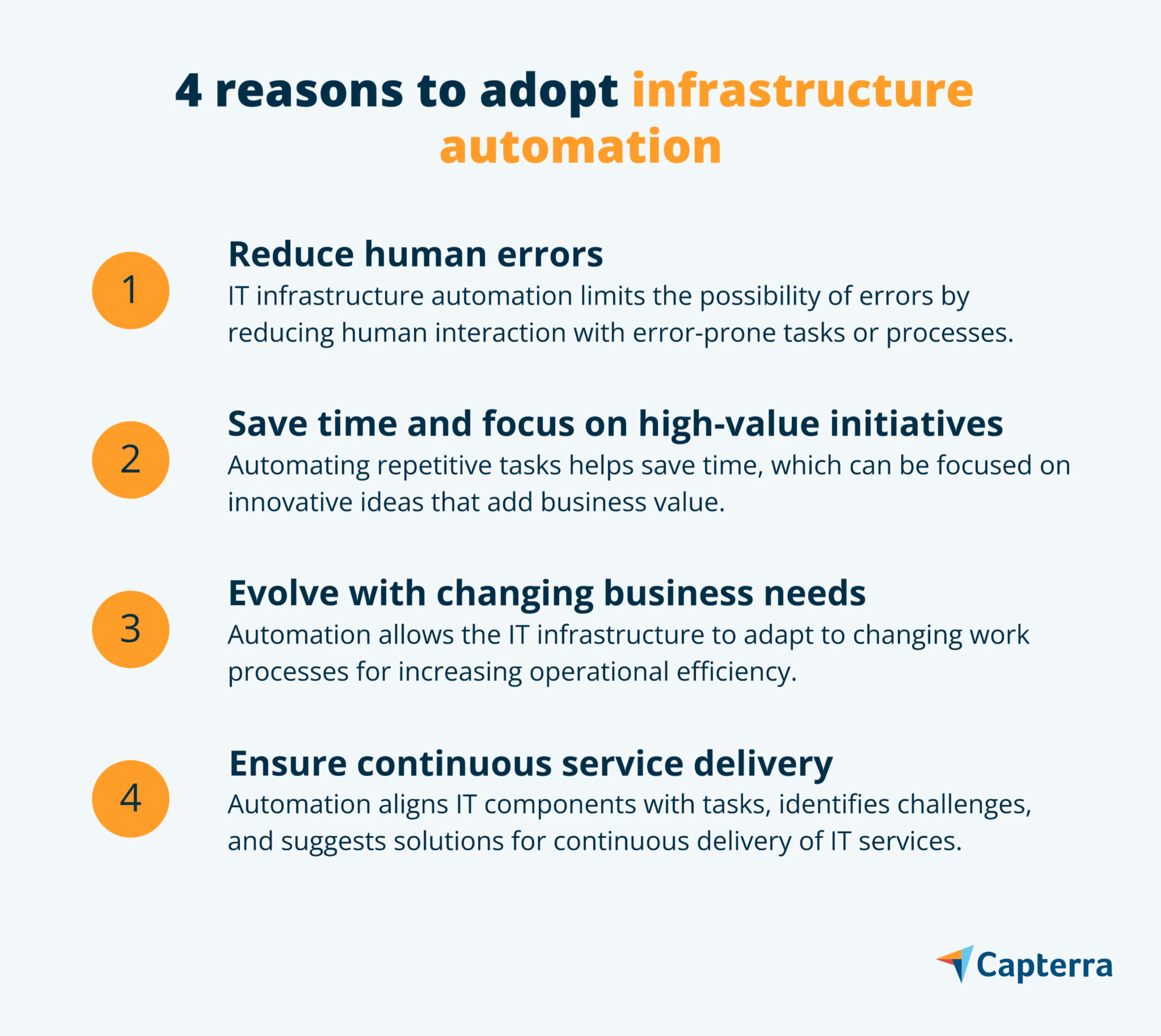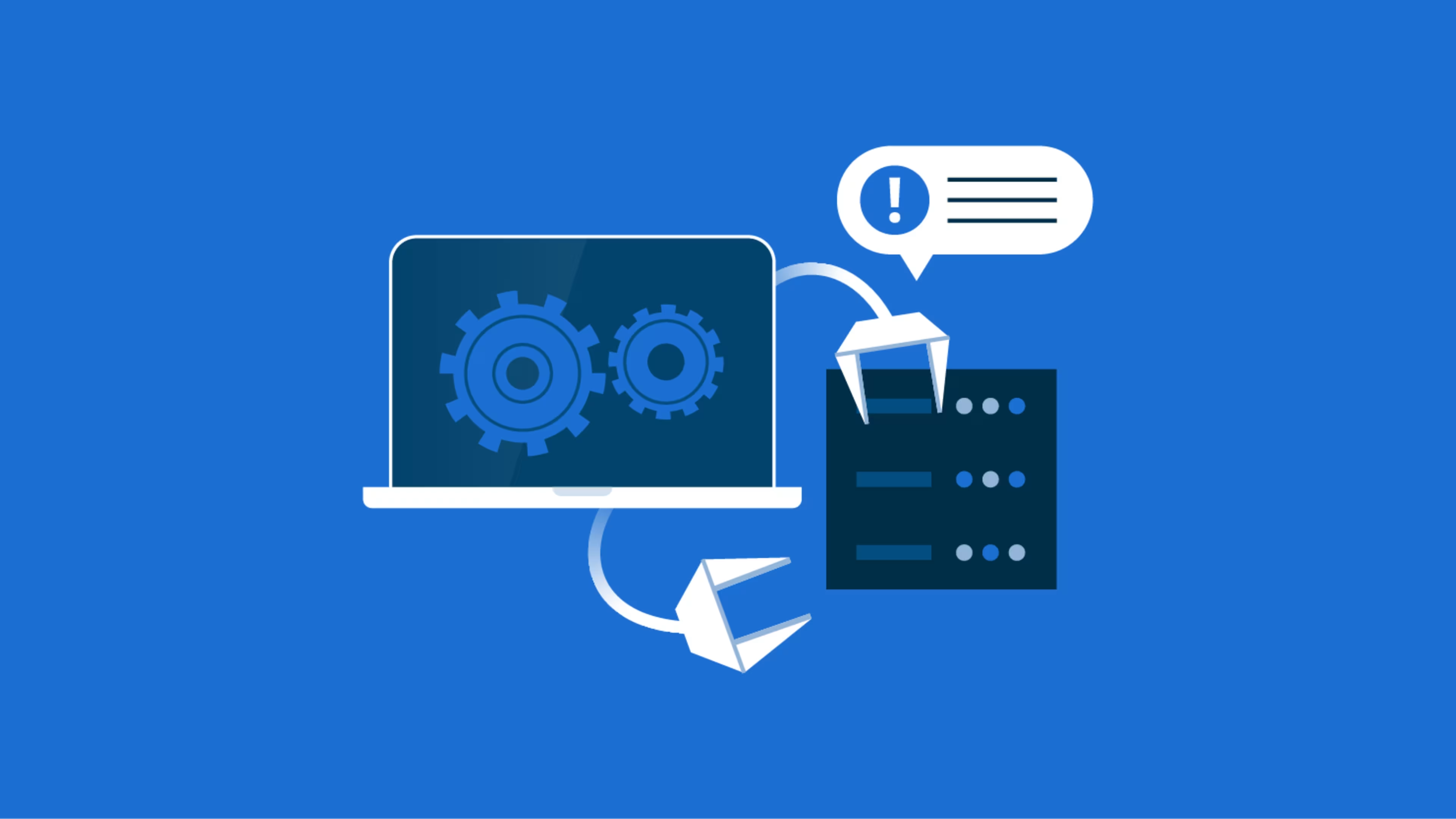Infrastructure automation helps tackle the complexities of scaling your business operations.
“Should you automate your IT infrastructure?” To answer this question, ask your IT team if they have enough time to plan for the installation of an advanced technology platform. If their response is a no, then probably it’s time to transform.
Usually, your IT team has more work than they can handle. Operational tasks such as routine maintenance and responding to breakdowns and incidents take most of the IT team’s capacity. This leaves them with little scope to work toward transforming or automating legacy infrastructure—one of the key reasons businesses fall behind their industry peers.
By automating IT infrastructure, you can eliminate repetitive manual tasks or processes to free up the capacity of your IT staff as well as reduce the chances of human error.
If you’re an infrastructure and operations (I&O) leader or IT manager who is responsible for modernizing legacy infrastructure and ensuring business processes are made more efficient through automation, this article is for you. Read on to understand what IT infrastructure automation is all about and why it’s important for your business operations.
/ What is IT infrastructure automation?
IT infrastructure automation is the process of limiting human interaction with IT systems to reduce manual errors and fast-track the completion of repetitive tasks, such as updating software applications across devices and running antivirus scans across servers. Its goal is to make processes more efficient and reduce the cost incurred on general IT repairs and maintenance.
Your IT infrastructure is made up of hardware, software, network, and data center. Employees depend on these components to complete their daily tasks. Automating the upkeep of these underlying infrastructure components ensures your business operations run seamlessly as well as saves time and money on IT infrastructure management and maintenance.
Why should you adopt IT infrastructure automation?
IT infrastructure automation enhances the way your business operates and accomplishes tasks. That’s the reason over 70% of businesses are expected to implement infrastructure automation by 2025, according to Gartner research[1].
Find providers that can help with your business needs by using our lists of managed service providers agencies by location.

1. Reduce human errors
Human errors have cost companies billions of dollars[2]. Errors may be accidental, and even though employees work hard to prevent them, a few could still slip through the cracks.
Having an automated workflow in your IT infrastructure limits the possibility of such errors by reducing human interaction with tasks such as allocating servers for data processing. This not only improves work quality but also enables you to focus on core development and innovation instead of rectifying errors.
Finance departments, for instance, can save their teams 25,000 hours of avoidable rework caused by human errors by implementing an automated workflow such as robotic process automation (RPA) in their financial reporting processes, according to Gartner research[3].
2. Save time and focus on high-value initiatives
It’s important to identify solutions that improve work processes and increase efficiency to help your business innovate and fast-track growth. This requires you to closely monitor the status of IT infrastructure and operations, identify challenges such as system breakdowns, and implement technology solutions to keep the work going.
However, the constant repetition of such tasks can eat away a lot of your time, which can instead be used for new developments that add business value. Having an infrastructure automation tool eliminates such repetitive tasks and allows you to focus on forward-thinking innovative ideas that give your business a competitive edge.
3. Evolve with changing business needs
Eliminating manual work is just one aspect of automating your technology infrastructure. It helps not only reduce tedious tasks and human errors but also identifies new growth opportunities for your business. Smart approaches to infrastructure automation, such as RPA, allow your infrastructure components to learn, adapt, and evolve with time.
With the help of automation, IT infrastructure components communicate with each other and make changes to or adjust work processes to achieve the desired results. The change could be a simple shift in the order of tasks in the daily workflow or a change in the way a technology solution is used to complete tasks. Infrastructure components learn from the introduced changes and adopt them for future work, thereby evolving themselves per the business needs.
4. Ensure continuous delivery of services for employees
Quick and reliable infrastructure provisioning and continuous deployment—i.e., allocating tasks to different infrastructure components—is essential, especially when working in a digital or cloud environment. It helps your IT infrastructure maintain continuous service delivery to ensure employees can complete everyday tasks without any issues.
An infrastructure automation tool allows IT infrastructure components to connect using codes—i.e., continuous integration. It quickly aligns the components with relevant tasks, identifies challenges in accomplishing those tasks, and suggests solutions to tackle the challenges and increase operational efficiency. This improves the overall workflow, which in turn translates into continuous configuration and delivery of IT services, with zero downtime for employees.
Alexey Sutyagin[4], engineering manager and R&D team lead at Gett, shares how IT infrastructure automation has turned out for his business:
"I found IT infrastructure automation very useful for the following reasons. Firstly, it helped us reduce our time-to-market by speeding up the feedback cycle. When we push a code to the Visual Code Studio (VCS), an environment for code testing is immediately created, allowing for quicker and more stable tests than before. This has helped us get our products to market faster. Secondly, we can now easily handle the surge in demand for products, which is a common problem in eCommerce and transport companies. With an automated pipeline for new market situations, we can offer an appropriate level of service to all customers."


Alexey Sutyagin
Engineering manager and R&D team lead at Gett
Is infrastructure automation always good?
Automation is essential for your business to increase productivity, simplify workflows, and enhance security. However, you should carefully consider its benefits and best practices to get your desired outcomes. If neglected, infrastructure automation can become a costly business affair. The video above highlights the advantages and disadvantages of automating your IT infrastructure.
/ Tips to automate your IT infrastructure
Before making up your mind to adopt IT infrastructure automation, consider the following tips for the best results and to avoid any unforeseen issues:
Develop a clear action plan, including a timeline and budget.
Identify manual processes that are more prone to human error, and consider automating them first.
Assess your current underlying infrastructure components, and determine the resources you’ll need to automate them.
Implement a training program for your internal teams to ensure a smooth transition to automated processes.
Regularly monitor the automated processes to identify and fix any issues.
Prepare for ongoing maintenance and updates to keep your automated infrastructure running smoothly.
What’s your takeaway?
Automation is a cost-effective technology to enhance your IT infrastructure and accelerate digital transformation. Automated processes allow infrastructure components to offer better technology services for employees to do their jobs. You should carefully consider the value automation adds to your business in terms of growth and adaptability.
Besides the benefits, you should also analyze employees’ attitude toward automating work processes. It should not, in any way, make them feel any less important or insecure about their jobs. Neglecting this aspect can lead to instability at work because an infrastructure automation tool is great, but it cannot eliminate human interactions.
Explore more Capterra resources on IT infrastructure management:

